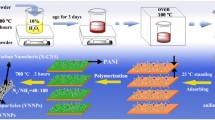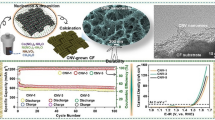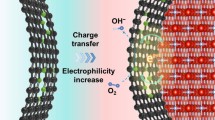Abstract
Vanadium nitride (VN) has received significant attention as a potential negative electrode material due to its remarkable theoretical and physical properties. However, the electrochemical performance needs to be improved due to its low specific surface area and the issue of being easily dissolved in electrolyte. Researches have shown that the composite structure of carbon-coated nanoscale VN particles could significantly increase the specific surface area of VN, and more importantly, and the carbon matrix can effectively restrain the dissolution of VN particles in the electrolyte, thereby improving its chemical and electrochemical performance, including specific capacity and cycling stability. Herein, VN quantum dots are synthesized and protected by uniformly coating the carbon skeleton on its surface via an in situ strategy of oxidation initiation, which initiates dopamine polymerization, forming a crystalline complex of polydopamine and vanadium. After heat treatment, the product is a composite material with VN quantum dots embedded in the amorphous carbon skeleton. The resulting small-sized and crosslinked carbon particles formed a graded pore structure, more reasonable channels provided for electrolyte ions transport quickly. When the composite material was used as the negative electrode material for supercapacitors, it exhibits the specific capacity of 391.9 F·g−1 at a current density of 0.5 A·g−1 and excellent capacity retention rate of 83.6% after 5000 cycles. The synthesis method of this quantum dot could be applied to other metal compounds and has potential applications in catalysis, environmental protection, and other fields.






Similar content being viewed by others
Data availability
The data generated during and/or analyzed in this article are available from the corresponding author on reasonable request.
References
Wang G, Wang H, Lu X, Ling Y, Yu M, Zhai T, Tong Y, Li Y. Solid-state supercapacitor based on activated carbon cloths exhibits excellent rate capability. Adv Mater. 2014;26(17):2676. https://doi.org/10.1002/adma.201304756.
Zhang Q, Zhang TT, Li FY, Xu L. Pompon-like NiCo2O4 nanospheres: a potential candidate for the counter electrode in quantum dot-sensitized solar cells. Tungsten.2023;5(2):235. https://doi.org/10.1007/s42864-022-00188-9
Kang R, Zhu WQ, Li S, Zou BB, Wang LL, Li GC, Liu XH, Ng DHL, Qiu JX, Zhao Y, Qiao F, Lian JB. Fe2TiO5 nanochains as anode for high-performance lithium-ion capacitor. Rare Met. 2021;40(9):2424. https://doi.org/10.1007/s12598-020-01638-4.
Wang JG, Kang F, Wei B. Engineering of MnO2-based nanocomposites for high-performance supercapacitors. Prog Mater Sci. 2015;74:51. https://doi.org/10.1016/j.pmatsci.2015.04.003.
Zhang D, Yang B, She W, Gao S, Wang J, Wang Y, Wang K, Li H, Han L. Simultaneously achieving high energy and power density for ultrafast-charging supercapacitor built by a semi-graphitic hierarchical porous carbon nanosheet and a high-voltage alkaline aqueous electrolyte. J Power Sources. 2021;506: 230103. https://doi.org/10.1016/j.jpowsour.2021.230103.
Zhao S, Song Z, Qing L, Zhou J, Qiao C. Surface wettability effect on energy density and power density of supercapacitors. J Phys Chem C. 2022;126(22):9248. https://doi.org/10.1021/acs.jpcc.2c01455.
Yang N, Ji L, Fu H, Shen Y, Wang M, Liu J, Chang L, Lv Y. Hierarchical porous carbon derived from coal-based carbon foam for high-performance supercapacitors. Chin Chem Lett. 2022;33(8):3961. https://doi.org/10.1016/j.cclet.2022.03.037.
Libich J, Máca J, Vondrák J, Čech O, Sedlaříková M. Supercapacitors: properties and applications. J Energy Storage. 2018;17:224. https://doi.org/10.1016/j.est.2018.03.012.
Xu B, Zheng M, Tang H, Chen Z, Chi Y, Wang L, Zhang L, Chen Y, Pang H. Iron oxide-based nanomaterials for supercapacitors. Nanotechnology. 2019;30(20): 204002. https://doi.org/10.1088/1361-6528/ab009f.
Ren K, Liu Z, Wei T, Fan Z. Recent developments of transition metal compounds-carbon hybrid electrodes for high energy/power supercapacitors. Nano-Micro Lett. 2021;13(1):129. https://doi.org/10.1007/s40820-021-00642-2.
Song Y, Liu T, Yao B, Li M, Kou T, Huang ZH, Feng DY, Wang F, Tong Y, Liu XX, Li Y. Ostwald ripening improves rate capability of high mass loading manganese oxide for supercapacitors. ACS Energy Lett. 2017;2(8):1752. https://doi.org/10.1021/acsenergylett.7b00405.
Geramifard N, Chakraborty B, Dousti B, Lee GS, Maeng J. High-energy-density sputtered iridium oxide micro-supercapacitors operating in physiological electrolytes. J Electrochem Soc. 2022;169(5): 050508. https://doi.org/10.1149/1945-7111/ac6a80.
Li Z, Wang F, Wang X. Hierarchical branched vanadium oxide nanorod@Si nanowire architecture for high performance supercapacitors. Small. 2017;13(1):1603076. https://doi.org/10.1002/smll.201603076.
Velasco A, Ryu YK, Boscá A, Ladrón-de-Guevara A, Hunt E, Zuo J, Pedrós J, Calle F, Martinez J. Recent trends in graphene supercapacitors: from large area to microsupercapacitors. Sustain Energy Fuels. 2021;5(5):1235. https://doi.org/10.1039/D0SE01849J.
Wang H, Liu X, Zhang B, Yang J, Zhang Z, Yue R, Wang Z. Highly compressible supercapacitor based on carbon nanotubes-reinforced sponge electrode. J Alloys Compd. 2019;786:995. https://doi.org/10.1016/j.jallcom.2019.01.303.
Liu T, Liu G. Block copolymer-based porous carbons for supercapacitors. J Mater Chem A. 2019;7(41):23476. https://doi.org/10.1039/C9TA07770G.
Li K, Zhang J. Recent advances in flexible supercapacitors based on carbon nanotubes and graphene. Sci China Mater. 2018;61(2):210. https://doi.org/10.1007/s40843-017-9154-2.
Hao P, Cui G, Shi X, Xie J, Xia X, Sang Y, Wong CP, Liu H, Tang B. High performance supercapacitors from hierarchical porous carbon aerogels based on sliced bread. Chin J Chem. 2017;35(5):699. https://doi.org/10.1002/cjoc.201600722.
Hanumantha PJ, Datta MK, Kadakia K, Okoli C, Patel P, Kumta PN. Vanadium nitride supercapacitors: effect of processing parameters on electrochemical charge storage behavior. Electrochim Acta. 2016;207:37. https://doi.org/10.1016/j.electacta.2016.04.058.
Yan H, Wang J, Fang Y, Zhou M, Guo X, Wang HQ, Dai Y, Li W, Zheng JC. Porous carbon anchored titanium carbonitride for high-performance supercapacitor. Electrochim Acta. 2019;304:138. https://doi.org/10.1016/j.electacta.2019.02.109.
Xie Y, Tian F. Capacitive performance of molybdenum nitride/titanium nitride nanotube array for supercapacitor. Mater Sci Eng B. 2017;215:64. https://doi.org/10.1016/j.mseb.2016.11.005.
Wazir MB, Daud M, Ullah N, Hai A, Muhammad A, Younas M, Rezakazemi M. Synergistic properties of molybdenum disulfide (MoS2) with electro-active materials for high-performance supercapacitors. Int J Hydrog Energy. 2019;44(33):17470. https://doi.org/10.1016/j.ijhydene.2019.04.265.
Majumdar D. Recent progress in copper sulfide based nanomaterials for high energy supercapacitor applications. J Electroanal Chem. 2021;880: 114825. https://doi.org/10.1016/j.jelechem.2020.114825.
Bo Z, Lu X, Yang H, Wu S, Cheng X, Gong B, Huang Z, Yan J, Cen K, Ostrikov K. Surface-dominant pseudocapacitive supercapacitors with high specific energy and power for energy storage. J Energy Storage. 2021;42: 103084. https://doi.org/10.1016/j.est.2021.103084.
Sahoo S, Kumar R, Joanni E, Singh RK, Shim JJ. Advances in pseudocapacitive and battery-like electrode materials for high performance supercapacitors. J Mater Chem A. 2022;10(25):13190. https://doi.org/10.1039/D2TA02357A.
Sharma A, Rout CS. 1T metallic vanadium disulfide hybridized with mxene and functionalized-mwcnt as a remarkable electrode for high power density asymmetric supercapacitor applications. Int J Energy Res. 2022;46(15):24537. https://doi.org/10.1002/er.8564.
Nagai M. Transition-metal nitrides for hydrotreating catalyst—synthesis, surface properties, and reactivities. Appl Catal A. 2007;322:178. https://doi.org/10.1016/j.apcata.2007.01.006.
Wu Y, Song TY, Chen LN. A review on recent developments of vanadium-based cathode for rechargeable zinc-ion batteries. Tungsten.2021;3(3):289. https://doi.org/10.1007/s42864-021-00091-9
Ningthoujam RS, Gajbhiye NS. Synthesis, electron transport properties of transition metal nitrides and applications. Prog Mater Sci. 2015;70:50. https://doi.org/10.1016/j.pmatsci.2014.11.004.
Lin L, Piao S, Choi Y, Lyu L, Hong H, Kim D, Lee J, Zhang W, Piao Y. Nanostructured transition metal nitrides as emerging electrocatalysts for water electrolysis: Status and challenges. EnergyChem. 2022;4(2): 100072. https://doi.org/10.1016/j.enchem.2022.100072.
Djire A, Pande P, Deb A, Siegel JB, Ajenifujah OT, He L, Sleightholme AE, Rasmussen PG, Thompson LT. Unveiling the pseudocapacitive charge storage mechanisms of nanostructured vanadium nitrides using in-situ analyses. Nano Energy. 2019;60:72. https://doi.org/10.1016/j.nanoen.2019.03.003.
Deng L, Gao Y, Ma Z, Fan G. Free-standing graphene/vanadium oxide composite as binder-free electrode for asymmetrical supercapacitor. J Colloid Interface Sci. 2017;505:556. https://doi.org/10.1016/j.jcis.2017.06.048.
Kim T, Kim H, You TS, Kim J. Carbon-coated V2O5 nanoparticles derived from metal-organic frameworks as a cathode material for rechargeable lithium-ion batteries. J Alloys Compd. 2017;727:522. https://doi.org/10.1016/j.jallcom.2017.08.179.
Guo J, Zhang Q, Sun J, Li C, Zhao J, Zhou Z, He B, Wang X, Man P, Li Q, Zhang J, Xie L, Li M, Yao Y. Direct growth of vanadium nitride nanosheets on carbon nanotube fibers as novel negative electrodes for high-energy-density wearable fiber-shaped asymmetric supercapacitors. J Power Sources. 2018;382:122. https://doi.org/10.1016/j.jpowsour.2018.02.034.
Gao B, Li X, Guo X, Zhang X, Peng X, Wang L, Fu J, Chu PK, Huo K. Nitrogen-doped carbon encapsulated mesoporous vanadium nitride nanowires as self-supported electrodes for flexible all-solid-state supercapacitors. Adv Mater Interfaces. 2015;2(13):1500211. https://doi.org/10.1002/admi.201500211.
Tan Y, Liu Y, Tang Z, Wang Z, Kong L, Kang L, Liu Z, Ran F. Concise N-doped carbon nanosheets/vanadium nitride nanoparticles materials via intercalative polymerization for supercapacitors. Sci Rep. 2018;8(1):2915. https://doi.org/10.1038/s41598-018-21082-w.
Wang Y, Jiang M, Yang Y, Ran F. Hybrid electrode material of vanadium nitride and carbon fiber with cigarette butt/metal ions wastes as the precursor for supercapacitors. Electrochim Acta. 2016;222:1914. https://doi.org/10.1016/j.electacta.2016.12.003.
Zhang W, Yang Y, Ravi M, Kong L, Kang L, Ran F. Interconnected porous composites electrode materials of carbon@vanadium nitride by directly absorbing VO3. Electrochim Acta. 2019;306:113. https://doi.org/10.1016/j.electacta.2019.03.112.
Yang Y, Shen K, Liu Y, Tan Y, Zhao X, Wu J, Niu X, Ran F. Novel hybrid nanoparticles of vanadium nitride/porous carbon as an anode material for symmetrical supercapacitor. Nano-Micro Lett. 2016;9(1):6. https://doi.org/10.1007/s40820-016-0105-5.
Yang Y, Wang Y, Zhao L, Liu Y, Ran F. Visualizing nucleation and growth process of vanadium-supramolecular nanoribbons self-assembled by rapid cooling method towards high-capacity vanadium nitride anode materials. Adv Energy Mater. 2022;12(13):2103158. https://doi.org/10.1002/aenm.202103158.
Liu Y, Wu Q, Liu L, Manasa P, Kang L, Ran F. Vanadium nitride for aqueous supercapacitors: a topic review. J Mater Chem A. 2020;8(17):8218. https://doi.org/10.1039/d0ta01490g.
Yang L, Guo X, Jin Z, Guo W, Duan G, Liu X, Li Y. Emergence of melanin-inspired supercapacitors. Nano Today. 2021;37: 101075. https://doi.org/10.1016/j.nantod.2020.101075.
Li Y, Xie Y, Wang Z, Zang N, Carniato F, Huang Y, Andolina CM, Parent LR, Ditri TB, Walter ED, Botta M, Rinehart JD, Gianneschi NC. Structure and function of iron-loaded synthetic melanin. ACS Nano. 2016;10(11):10186. https://doi.org/10.1021/acsnano.6b05502.
Sun L, Wang C, Wang X, Wang L. Morphology evolution and control of mo-polydopamine coordination complex from 2D single nanopetal to hierarchical microflowers. Small. 2018;14(27):1800090. https://doi.org/10.1002/smll.201800090.
Wang Z, Zou Y, Li Y, Cheng Y. Metal-containing polydopamine nanomaterials: catalysis, energy, and theranostics. Small. 2020;16(18):1907042. https://doi.org/10.1002/smll.201907042.
Matsumura K, Iwama E, Takagi K, Hashizume N, Chikaoka Y, Okita N, Naoi W, Naoi K. Spray-drying synthesis and vanadium-catalyzed graphitization of a nanocrystalline γ- Li3.2V0.8Si0.2O4/C anode material with a unique double capsule structure. J Mater Chem A. 2023;11(4):1841. https://doi.org/10.1039/D2TA07825B.
Huangfu C, Liu Z, Lu X, Liu Q, Wei T, Fan Z. Strong oxidation induced quinone-rich dopamine polymerization onto porous carbons as ultrahigh-capacity organic cathode for sodium-ion batteries. Energy Storage Mater. 2021;43:120. https://doi.org/10.1016/j.ensm.2021.08.043.
Wang J, Polleux J, Lim J, Dunn B. Pseudocapacitive contributions to electrochemical energy storage in TiO2 (anatase) nanoparticles. J Phys Chem C. 2007;111(40):14925. https://doi.org/10.1021/jp074464w.
Liu TC, Pell WG, Conway BE, Roberson SL. Behavior of molybdenum nitrides as materials for electrochemical capacitors: comparison with ruthenium oxide. J Electrochem Soc. 1998;145(6):1882. https://doi.org/10.1149/1.1838571.
Liu Y, Liu L, Kong L, Kang L, Ran F. Supercapacitor electrode based on nano-vanadium nitride incorporated on porous carbon nanospheres derived from ionic amphiphilic block copolymers & vanadium-contained ion assembly systems. Electrochim Acta. 2016;211:469. https://doi.org/10.1016/j.electacta.2016.06.058.
Peng Y, Yu M, Zhao L, Ji X, He T, Liu Y, Wang Q, Ran F. 3D layered nanostructure of vanadium nitrides quantum dots@graphene anode materials via in-situ redox reaction strategy. Chem Eng J. 2021;417: 129267. https://doi.org/10.1016/j.cej.2021.129267.
Liu J, He X, Guo F, Liu B, Sun Z, Zhang L, Chang H. Vanadium nitride nanoparticle decorated N-doped carbon nanotube/N-doped carbon nanosheet hybrids via a C3N4 self-sacrificing method for electrochemical capacitors. RSC Adv. 2022;12(24):15354. https://doi.org/10.1039/d2ra02789e.
Qu Q, Zhang P, Wang B, Chen Y, Tian S, Wu Y, Holze R. Electrochemical performance of MnO2 nanorods in neutral aqueous electrolytes as a cathode for asymmetric supercapacitors. J Phys Chem C. 2009;113(31):14020. https://doi.org/10.1021/jp8113094.
Zhu J, Xu Z, Lu B. Ultrafine au nanoparticles decorated NiCo2O4 nanotubes as anode material for high-performance supercapacitor and lithium-ion battery applications. Nano Energy. 2014;7:114. https://doi.org/10.1016/j.nanoen.2014.04.010.
Song Z, Zhu D, Xue D, Yan J, Chai X, Xiong W, Wang Z, Lv Y, Cao T, Liu M, Gan L. Nitrogen-enriched hollow porous carbon nanospheres with tailored morphology and microstructure for all-solid-state symmetric supercapacitors. ACS Applied Energy Mater. 2018;1(8):4293. https://doi.org/10.1021/acsaem.8b00928.
Acknowledgements
This work was partly supported by the National Natural Science Foundation of China (51763014, and 52073133), Key Talent Project Foundation of Gansu Province, the Program for Hongliu Distinguished Young Scholars in Lanzhou University of Technology, a Joint fund between Shenyang National Laboratory for Materials Science and State Key Laboratory of Advanced Processing and Recycling of Nonferrous Metals (18LHPY002), and the Incubation Program of Excellent Doctoral Dissertation-Lanzhou University of Technology.
Author information
Authors and Affiliations
Corresponding author
Ethics declarations
Conflict of interest
The authors declare no conflict of interest.
Additional information
Publisher's Note
Springer Nature remains neutral with regard to jurisdictional claims in published maps and institutional affiliations.
Supplementary Information
Below is the link to the electronic supplementary material.
Rights and permissions
Springer Nature or its licensor (e.g. a society or other partner) holds exclusive rights to this article under a publishing agreement with the author(s) or other rightsholder(s); author self-archiving of the accepted manuscript version of this article is solely governed by the terms of such publishing agreement and applicable law.
About this article
Cite this article
Fu, YH., Peng, YY., Zhao, L. et al. Vanadium nitride quantum dots@carbon skeleton anode material synthesized via in situ oxidation initiation strategy. Tungsten (2023). https://doi.org/10.1007/s42864-023-00246-w
Received:
Revised:
Accepted:
Published:
DOI: https://doi.org/10.1007/s42864-023-00246-w




